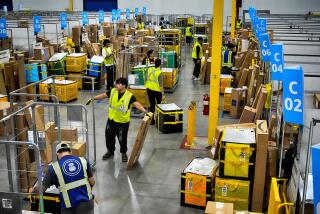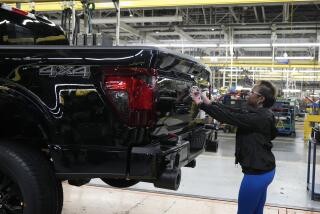Job Cuts Boost Efficiency 2.5%
WASHINGTON — Corporate America grew more efficient in coping with the nation’s economic slowdown this spring, but almost entirely by laying off workers and cutting their hours, the Labor Department said Tuesday.
Productivity, which measures a worker’s output per hour, climbed at an unexpectedly healthy 2.5% annual pace during the three-month quarter, the department said. That was a substantial improvement over the minuscule 0.1% pace businesses recorded during the previous quarter, and it reassured analysts that many of the efficiency gains of the late 1990s were surviving the economy’s current stumble.
Still, the new figures show that the gains did not come as Americans have been conditioned to expect in recent years--through the application of new high-tech equipment. Instead, they were achieved the old-fashioned way, by cutting labor in times of trouble. The latest numbers gave no indication when a robust economy would return.
“The numbers show business is responding aggressively by cutting production and hours,” said Mickey D. Levy, chief economist with Bank of America in New York. “It’s an unpleasant but necessary adjustment.”
Workers’ hours tumbled at a 2.4% annual pace during the quarter, their steepest drop in more than a decade, according to the department. By contrast, output as measured by the productivity numbers increased at only a 0.1% rate, its slowest pace in more than eight years.
Employers eliminated 217,000 jobs from March to June, the biggest quarterly job loss since the recession of 1991, a separate Labor Department report showed.
And the decline in hours and jobs was the least of the unpleasant news in the new numbers.
Figures showed that the efficiency of the nation’s manufacturing sector, which had been steadily improving, has tumbled this year as production declines have outpaced manufacturers’ ability to unload workers. Manufacturing productivity slipped at a 3.6% annual rate during the first three months and 0.2% in the second three months.
In addition, in a move suggesting that the most exuberant claims for the high-tech New Economy were more hype than reality, the government revised downward its overall productivity figures for the red-hot growth years of 1998 through 2000.
The revisions shrank the rate for 2000 from a wildly high 4.3% to a still respectable 3% and made smaller adjustments in figures for the other years.
“The changes show we’re not as well off as we thought we were a few years ago,” said William Dudley, chief U.S. economist with Goldman Sachs & Co. in New York.
Still, most analysts interpreted the new numbers as showing that the economy is hanging onto most of the efficiency improvements made in the 1990s and is poised to expand faster than it otherwise would when strong growth finally returns.
“We’re going to be starting from a pretty high base,” said Laura D’Andrea Tyson, dean of the business school at UC Berkeley and former economic advisor to President Clinton. “Only a few years ago, we thought the very best we could do on productivity was 1.6%. Now we have 2.5% at a time when you might think it would be declining.”
The new productivity numbers did nothing to signal when growth might revive, but other economic news of the day suggested that recovery could be some time in coming.
Consumer borrowing, which helped underwrite much of the 1990s boom, fell in June for the first time in almost four years as Americans cut back on car loans, according to new Federal Reserve figures.
Meanwhile, consumer product titan Procter & Gamble Co. announced its first quarterly loss in eight years, a $320-million setback because of the shutdown of unprofitable businesses and layoffs of 9,600 workers. And computer networking giant Cisco Systems Inc. said it ended its fiscal year in July with a loss of $1.01 billion and predicted sales declines in the coming year.
The latest corporate bad news, together with the slip in consumer borrowing, left the stock market uncertain. The Nasdaq Composite Index slid 6.47 points, or 0.3%, to close at 2027.79. Meanwhile, the Dow Jones industrial average rose 57.43, or 0.6%, to 10,458.74 and the Standard & Poor’s 500 Index crept up 3.92, or 0.3%, to 1204.40.
Although some have worried that recent layoffs could set off a downward spiral of consumer retrenchment leading to corporate production cuts and still more layoffs, analysts said Tuesday’s statistics suggested the worry may be overdone.
That is because the new figures showed that hourly compensation is still rising despite the slowdown. Real nonfarm business compensation rose 1.6% in the April-through-June quarter, up from 0.9% during the January-March quarter.
But analysts were hard-pressed to predict what will kick the economy back into high gear. Gross domestic product, the total of all goods and services produced in the U.S., rose at only a 0.7% annual rate in the second quarter, its slowest pace in eight years. The quarter was the fourth in a row in which growth was less than 2%, a far cry from the 4%-plus rates of the last years of the ‘90s.
Analysts are especially concerned about productivity because its robust rise produces all sorts of positive consequences for the country. Among them: the opportunity for faster economic growth without the danger of inflation, higher tax revenue and a larger pie to be divided among Americans. A slowdown or outright decline results in the opposite.
Federal Reserve Chairman Alan Greenspan has said repeatedly in recent months that the productivity gains of the last decade would be tested during the current slowdown, and a variety of economists and policymakers have worried that the improvements were beginning to fade.
But the Fed chairman has asserted that productivity is holding its own. “The productivity data, which have shown softness in the last two or three quarters, have come down pretty much in line with what one would expect if the underlying trend were rising,” he said in congressional testimony last month.
A variety of analysts said the new figures supported Greenspan’s view by showing productivity rising even as the overall economy slowed. But some warned that the latest statistics could well be revised downward, as previous years’ numbers were Tuesday.
If that happens, the economic accomplishments of the last decade could lose much of their remaining glow. “Let’s not uncork the champagne quite yet,” sad Paul L. Kasriel, research director with Northern Trust Co. in Chicago.
RELATED STORY
Borrowing less: Credit spending falls after four years on the rise. C1
(BEGIN TEXT OF INFOBOX / INFOGRAPHIC)
Productivity
Nonfarm business productivity; percentage change from previous quarter at annual rate, seasonally adjusted:
*
+2.5%
*
Source: Labor Department
AP / Los Angeles Times
More to Read
Inside the business of entertainment
The Wide Shot brings you news, analysis and insights on everything from streaming wars to production — and what it all means for the future.
You may occasionally receive promotional content from the Los Angeles Times.










